Nilab Rahmani and her family are among the few who were airlifted to Canada after the Taliban takeover on Aug. 15, 2021.
“We feel safe here [in Canada],” says the 20-year-old. The sight at Kabul airport on Aug. 25, the day they took the flight out of Afghanistan towards Canada, still haunts her.
Canada committed to resettle 40,000 Afghan evacuees on Sept. 27th, but as of time of writing, only 3,730 have made it, according to Immigration, Refugees and Citizenship Canada data.
Thousands jostled to get on evacuation flights, “mostly without visas,” says Nilab. The U.S. military aircraft that was designed to seat a little over a hundred soldiers, was packed with well over 600 evacuees. There were no seats left for her family.
Wedged between 500 people on the floor of the aircraft, Nilab, her two sisters, two brothers (aged 11 to 24 years) and mother took off for Toronto, leaving their home and all possessions behind.
Nilab speaks softly in Farsi through a Facebook Messenger audio call from her government-sponsored hotel room in Ottawa. Her Canadian cousin, Frozan Rahmani, who lives nearby, is with her to translate her words into English.
“They arrived in just one set of clothes and mobile phones,” says Frozan, a former journalist from Afghanistan who moved to Canada 10 years ago.
After four weeks in hotels, it’s time for Nilab and her family to look for a home in Ottawa. But that’s easier said than done.
“Most landlords are rejecting refugees with no jobs, no bank account, no criminal record checks,” explains Frozan.
Frozan is also concerned about her family back in Afghanistan who she has been unsuccessfully trying to sponsor. Private sponsorship has been slow. The first charter flight carrying 250 privately sponsored Afghans landed in Pearson International Airport on Dec. 2.
Kabul to Canada
“My father was in the Afghan army working with Canadian troops. In July 2019, he was shot dead by the Taliban after a suicide car bomb blast left him injured,” Nilab says through Frozan.
A week before her father was killed, the Taliban had seized Mazhar-i-Sharif in northern Afghanistan. “Still, we never imagined they would capture Kabul,” explains Nilab about their shock and desperation to leave Afghanistan.
Things changed overnight after the extremist soldiers seized Kabul on Aug. 15 and imposed Sharia law. Nilab says girls were banned from education and jobs, and unmarried girls as young as 12 were pushed into marriage with Taliban soldiers.
“Families pulled their daughters out of schools. I left Kabul university after a bomb blast killed students and teachers right before my eyes. It was horrible,” says Nilab.
As the situation spiraled out of control, the Canadian government prepared an evacuation plan for vulnerable Afghans. Wasting no time, the Rahmanis applied and qualified for their visas.
At Pearson Airport, the Catholic Centre for Immigrants (CCI) was waiting to welcome all evacuees. Settlement agencies have been working closely with the Canadian government to provide aid.
The CCI drove them to a hotel to serve out their mandated two-week quarantine, although the Rahmanis were among the fortunate 30 per cent who had been fully vaccinated in Afghanistan. In the week of their takeover, the Taliban banned COVID-19 vaccinations in eastern Afghanistan’s Paktia region, and are known to be hostile towards vaccinations in general.
The first night, the sisters were given donated clothes, but the brothers were not so fortunate. The Indian food was also too spicy for their taste. Over the next few days, they would slowly acclimatize to their new environment.
Two weeks later, the government asked them to move to Saskatchewan or Manitoba to start their new lives. However, the Rahmanis requested to be transferred to Ottawa, where Frozan was waiting for them. The CCI complied, with the consent of the government. They were dropped off at the doorstep of an inn, under the care of a CCI worker who was attending to 160 refugees in the city.
Ottawa: understaffed
The Calgary-based CCI is understaffed in Ottawa, explains Frozan. Interpreters are hard to locate.
“I try to help as much as possible but I can’t be there for them all the time,” she says, sounding concerned.
Frozan lends a hand to the newly launched Afghan Canadian Support Network, a donation centre that faces its own challenges in the midst of the pandemic.
The Network is asking for new items instead of used donations to prevent COVID-19 transmission through distribution. But all donations are used, including clothes.
“We have to wash and dry everything to minimize risks for the staff handling them,” explains Frozan.
Donation centres are asking for used furniture as well. “But we don’t have the resources to provide everything nor have the means to transport them,” she says.
Toronto: limited space
Adreena Niazi, founder and executive director of the Afghan Women’s Organization (AWO), is overwhelmed with the support in densely populated Toronto, but she says it’s not enough to help the refugees flooding in. Her four centres in the GTA are all short of space.
“We have 120 workers. Our volunteers have tripled. Corporations, hotels and mosques are all coming forward to help.
“We want to sponsor more refugees but we need more room,” says Niazi.
Niazi, a former professor of English literature at Kabul University, initially set up the AWO in June 1990 to teach English to Afghan women. Two years after the AWO’s inception, counselling and settlement services were extended to help refugees from other communities get oriented in Canada.
Niazi is a refugee herself who immigrated to Canada in 1988 to flee the Soviet coup in Afghanistan that led to persecution of her countrymen. She empathizes with the predicament of the new evacuees.
“We have a contract from the government to sponsor refugees. But we cannot because we don’t have the capacity or resources to sponsor more,” she says.
There are other challenges.
“The majority cannot speak English. Housing costs are high. We are encouraging them to go for shared housing because they cannot afford the rent,” she explains.
“Other refugees, like the Syrians, came in gradually [so they were more prepared]. For Afghans, the Taliban takeover was so fast, so unexpected, many fled in just one set of clothes, so everything had to be provided.”
Niazi says the government has been generous in staffing organizations and hospitals, especially for mental health services.
“Afghans have gone through a big shock and trauma after the Taliban took over. Mental health is a big concern,” she says.
Niazi estimates around 2,700 Afghan refugees are in Toronto. The federal government is encouraging refugees to settle in Saskatchewan and Manitoba to distribute the weight.
“I think it’s a good move. I don’t know if Toronto and Ottawa have the capacity to take them all. I don’t know if the school boards have the budgets to expand their classes. Housing in Manitoba and Saskatchewan will be more affordable,” she says.
Afghanistan: a battlefield
“Afghanistan was once a peaceful country,” Niazi reminisces. “Women were modern and educated. I wore skirts, never covered my hair or felt restricted.”
But invasions by the Soviet Union, followed by civil war, wreaked havoc.
“USA supported Afghanistan and our country became a battlefield between two superpowers — the USA and the Soviet Union. Now, people are running from the Taliban.”
Frozan shares her concerns. She is anxiously waiting to hear back from the IRCC on visas for her family back home, but so far, there is no progress.
“My family is among many Afghans who are in grave danger in Kabul,” she explains. “Since Canada announced the humanitarian program, only a handful have arrived. We are hoping Canada will do this successfully. Lots of people are waiting for their applications to process.”
Collective Convenor & Communications Planner - Joyeeta Ray is a multimedia journalist, internationally awarded digital content specialist, and children’s books author, based in Toronto. Born in India, she brings over two decades of advertising and journalism experience across seven countries to Canada. Joyeeta started her journalistic career in Jakarta, led an editorial team in Bangkok, and is a student of Multimedia Journalism from The University of Toronto. She is an enthusiastic NCM-CAJ member, actively involved in amplifying new Canadian voices as NCM’s Convenor, Communications Planner, Mentor, and Reporter.

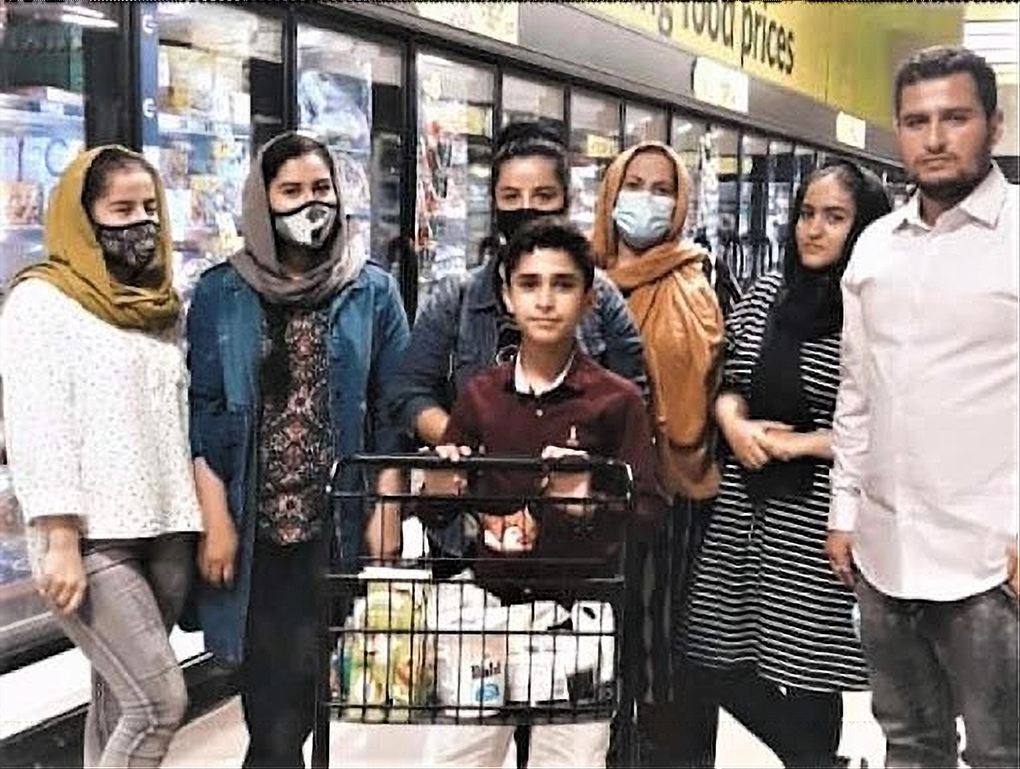
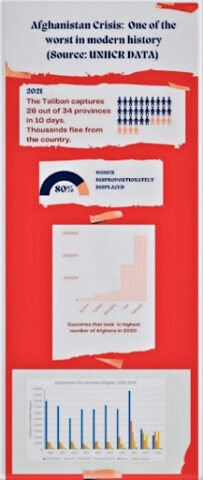
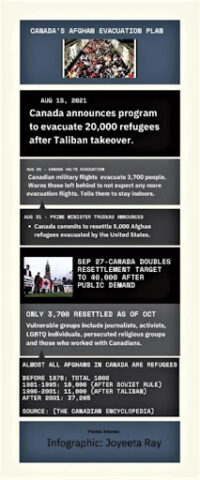
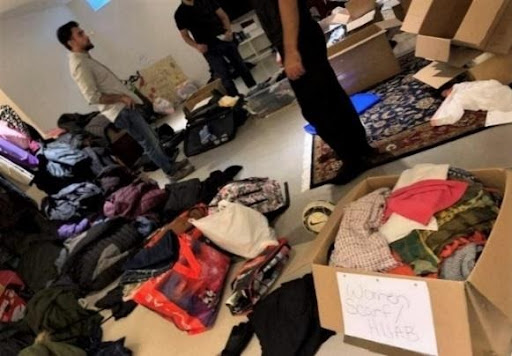
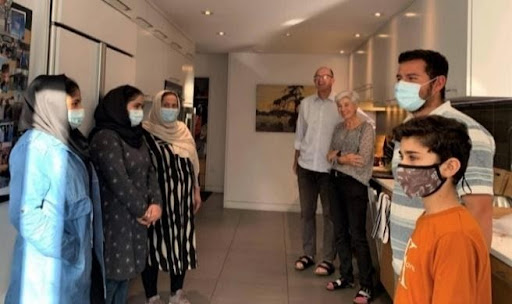

The portrayal of the refugees is indeed heart wrenching,bringing their tremendous everyday struggles and an uncertain future to the forefront!
So glad the family is in Canada, it’s horrifying what they went through hoping all works out well for them and other Afghan refugees